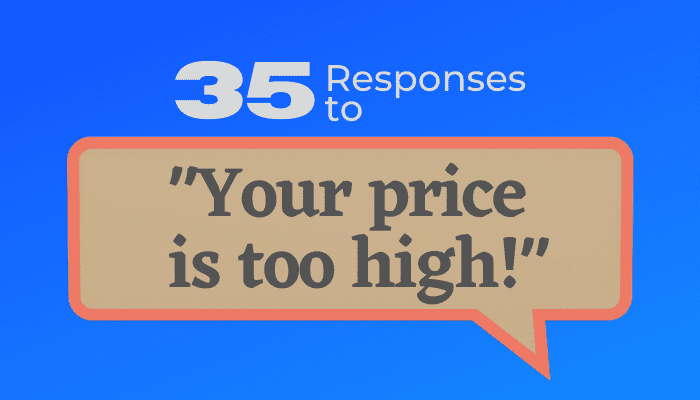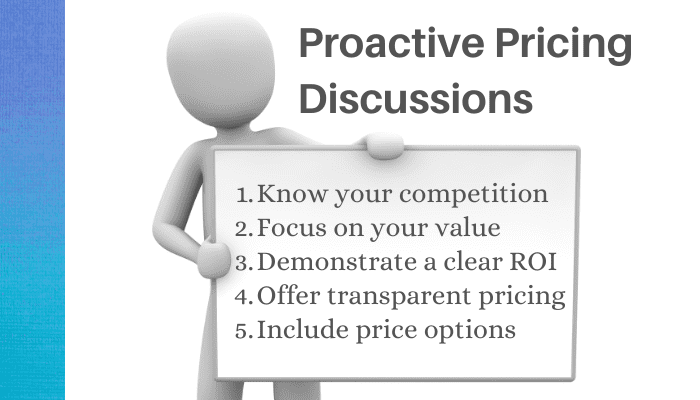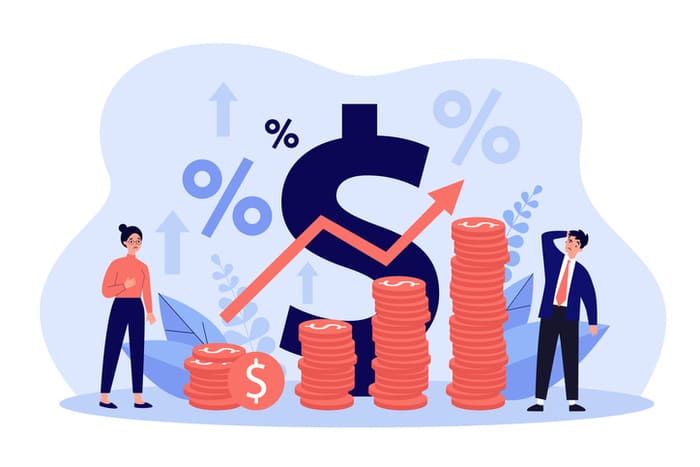If you’re in sales, then invariably you’ve had a customer push back, suggesting your price is too high.
It’s happened to the best of us.
In fact, I might even argue that if you haven’t had pushback on your pricing, you’re undervaluing your product or service.
This isn’t to dive into pricing theory per se, but pricing objections are one of the most common objections you’re likely to encounter when selling.
Let’s talk about how to handle price objections.
When to Discuss Price (There is a Right and Wrong Time)

Considering that they’re common sales objections, it’s important to know how to overcome price objections.
A proactive approach is to bring up price during your discussion, and deal with any objections.
Speed and efficacy are key.
Anything less can appear misleading.
There are some simple strategies you can use to be proactive and initiate the conversation.
5 Steps to a Proactive Pricing Discussion
1. Know your competition
Be clear on who your closest competitors are, and understand how your product or service differs. When I was selling Pontiac Vibes back in the early 2000s, I knew my closest competitor was the Toyota Matrix (both produced at the same production plant). I made it my job to know how the Pontiac differed, and what the drawbacks to the Matrix were.
2. Focus on value
Those that bring up a price objection typically already know what your competitors’ product or service is, and how it differs from yours. Continually focus your presentation on the value of investing in your product or service. What value can you bring that is beyond just the product itself? Better customer service? Longer warranty periods? Fewer returns?
3. Have a clear ROI
When speaking of your product or service, be clear on the return it provides. A sale is an exchange of currency for something the customer values. The stronger the return on investment, and the more you can share this, the easier the sale becomes. What is the return on investment of your product or service?
4. Offer transparent pricing
Don’t try to avoid or delay discussing price. Delaying a price discussion (or waiting until asked) only leads to suspicion on the part of the customer. This isn’t to say you should lead with price, but if it isn’t already clear, make sure bringing up the price is something you do early on, once you’ve tackled the three points above.
5. Include price options
When a price is a black or white decision, the odds are stacked against you. When you can include options, you have a significantly increased opportunity to close the sale. Make sure you include options at different price points.
“Your Price Is Too High” Responses
Presuming you’ve been proactive about your pricing discussions, invariably you may still periodically get pushback on your pricing.
This may come in the form of a response like “We’ll get back to you,” or possibly the customer will be downright insulted.
Responses can vary widely.
Sticker shock, as it’s sometimes referred to, is something every salesperson faces, and to be truthful, the more you sell, the more often you’ll be faced with this objection.
The key is to always be proactive, as described above; however, being ready for a price objection is your second-best weapon.
Additionally, behind every objection, there is often a deeper issue that may not be understood.
By responding strategically to the “your price is too high” objection, you can uncover what the real concerns are.
Rarely are they about money.
Most often they are a misunderstanding that requires further clarification.
Here are 35 responses you can use when your customer gives you the cold shoulder after pricing has been discussed:
35 Responses to Your Price Is Too High

How to Get the Customer to Share Why They Have Price Objections
- Say nothing: When the customer brings up a price objection, say nothing. This can feel very uncomfortable but often gets the customer to open up about why they are concerned with the price.
- Agree with the customer: This is something that Grant Cardone recommends you do with every objection. First agree with the customer: “I can see why you might think this price is high, but….”
- Reconfirm value: Repeat back to the customer what value they will get for their investment.
- Reconfirm ROI: Repeat back to the customer what the ROI is they are achieving through their investment.
- Try a smile: Similar to the “say nothing” approach, by simply smiling you can often get the customer to open up further about their concerns.
- Repeat your price: By repeating your price, you reinforce the investment which can drive the customer to ask more questions, further acknowledging why they have pricing concerns.
How to Respond Directly to a Price Objection
- “This is a great deal, I can reassure you.”
- “Our offer is more than competitive. Let me give you an example.”
- “Hmm, I may have missed explaining something correctly. Let me reconfirm what you get.”
- “Some of our best customers initially thought the same thing, however…”
- “Let me just list off what’s included with our offer here.”
- “Well, it’s only money. If this improves your life the way we think, won’t it be worth it?”
- “May I ask you a question? Is there something else here that’s concerning you?”
- “We are higher priced than our competitors, but let me touch again on why that is.”
- “As the old saying goes, you get what you pay for.”
- “Would you agree to speak to a customer who had the exact same concerns?”
- “If we can deliver this return on investment, won’t it be worth it?”
- “Maybe I haven’t explained this as well as I could have. Would you mind if we spoke with my boss?”
- “Our prices have been increasing annually for years now. The sooner we get you locked in at this price, the better.”
- “I thought the same thing you did a few years ago. But so many customers have enjoyed this product, I know you will too.”
- “May I ask, is there someone else we should discuss this with before we walk away?”
- “If now isn’t a good time, would there be a better time to look at the investment?”
- “Let me talk to my boss and see what I can do. Can you wait here a minute?”
- “It may seem high, but trust me, this is a great deal. Let me show you again what you’ll get.”
- “Let’s compare what we’re offering you to our closest competitor, shall we?”
Additional Strategies to Respond to Sticker Shock

- Ask more questions: Probe deeper with the customer to understand why they think your price is too high.
- Solicit more objections: Ask your customer, before you look at the price, if there is anything else that’s stopping them from proceeding.
- Suggest an alternative: If you have other products or services, offer them as an alternative.
- Add incentives: Offer to throw in other incentives or value to make the price seem lower in comparison to the original offer.
- Dismantle your offer: Remove some of the features of what you are offering to lower the price (this isn’t always possible, of course, but it’s an option).
- Payment options: Put forward different options for how the customer might pay, which reduces the initial cost. Longer terms, as an example, can lower payments.
- Ask for referrals: Suggest that if the customer knows someone else who might enjoy the same product or service, you may be able to provide them a discount equivalent to a referral fee.
- Ask for a testimonial: In some instances, a testimony can have value. If the customer provides you with a video testimony, are you able to provide a further incentive or discount? Think of it as an investment in marketing.
- Shift responsibilities: In some instances, shifting some of the responsibilities to the customer can allow you a chance to reduce the price. What is the customer willing to do that will reduce your company’s time/effort/investment in the product or service?
- Change your price: This one might seem obvious, but if you are continually faced with overcoming price objections, maybe it’s time to look at your price.
Dealing with “Your Price Is Too High” Objections

There are numerous ways you can approach a price objection.
Always be proactive, and practice the various responses above, selecting those that you are most comfortable with.
By being ready, you’ll never miss a beat if your customer complains that your product costs too much or your price is too high.
Often that is your best defense on how to overcome price objections.
© Shawn Casemore 2022. All Rights Reserved.



Share This Article
Choose Your Platform: Facebook Twitter Google Plus Linkedin